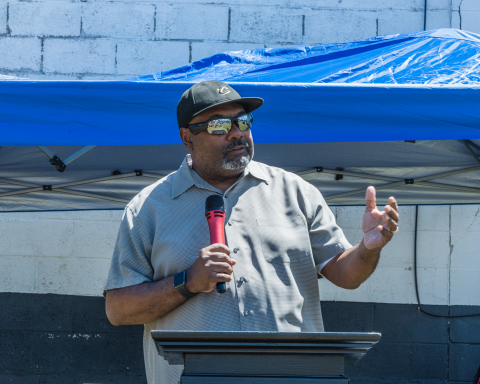As the National Initiative on Mixed-Income Communities (NIMC) reflects on our first decade of research and consulting on urban equity and inclusion, one of our key partners, the Cuyahoga Metropolitan Housing Authority (CMHA) recently marked its 90th anniversary. This key local partnership has enabled us to share our mixed-income experience and learning in the most recent phase of CMHA’s legacy as the first chartered housing authority in the U.S., established in 1933.
NIMC and CMHA are currently collaborating on the Woodhill-Buckeye Choice Neighborhoods Initiative – a multiyear mixed-income transformation on the east side of Cleveland supported by $47 million in HUD Choice Neighborhoods Initiative grant funding. CMHA is the lead institution for this cross-sector collaboration and NIMC is supporting the coordination of the initiative, with a focus on operations, governance and engagement strategies.
NIMC Founding Director Mark Joseph connected with Jeffrey Patterson, the longtime CEO of CMHA, for a 10th anniversary reflection conversation, offering a glimpse into the growth of both organizations over the past ten years and CMHA’s progress toward making Cleveland neighborhoods more inclusive with the help of NIMC.
MJ: CMHA has been one of NIMC's longstanding local partners in Cleveland. Thank you! How would you describe NIMC's general value to local community development in Cleveland?
JP: NIMC's value to the community development in Cleveland is very significant. NIMC's presence, passion and contributions have been critical to the success of several initiatives in our community
MJ: You are a national leader in the housing field, including your role as Board President of CLPHA, the Council of Large Public Housing Authorities. So you've also seen NIMC on a national stage. What reflections do you have about that?
JP: It is refreshing to see how NIMC has been able to influence our industry on both a local and national level. Your inclusive style and deep-rooted community perspective has aided the affordable housing industry in many ways including ensuring that resident engagement and participation are not only included but are also respected.
MJ: And how about NIMC's specific working relationship with CMHA, how would you describe NIMC's value to you and your CMHA colleagues?
JP: NIMC has an excellent relationship with CMHA and has been a true partner in our Choice Neighborhoods initiative. Your grassroots hands-on approach to community engagement has been a vital part of the success of this initiative so far. NIMC's strength is your ability to bring people together and to make sure everyone feels like they belong and are heard.
MJ: You've watched us grow and mature over the last ten years, what have you observed in NIMC's journey over the last decade?
JP: It is always exciting to see organizations grow and develop. I remember how passionate your group was when you all started and ten years later the energy is not only still there but has been amplified. The vision for the organization is still strong but the number of people who share and support this vision has grown tremendously. This is a testament to the leadership of NIMC.
MJ: How has NIMC impacted your own thinking and work?
JP: NIMC impacted my thinking as it relates to inclusivity and strategies and shapes not only our work with you but also in our overall day-to-day operations.
MJ: Final question – what advice do you have for NIMC as we look to continue to strengthen our changemaker role in our next decade?
JP: Stay focused on your vision and mission, remain committed to the work, and don't lose that passion and energy that makes NIMC such a champion to the community.


